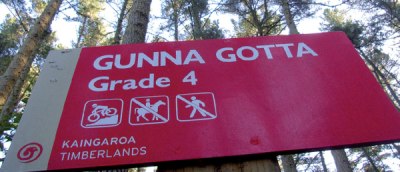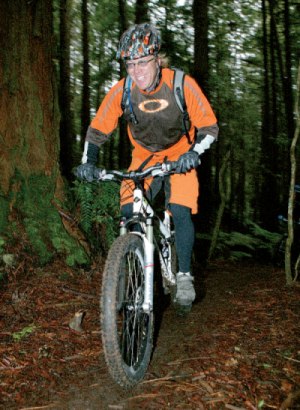Not in my Backyard!
Too many times in the world of trail advocacy there is the attitude of riders and locals to scream ‘not in my backyard!’ I do not want anyone else to know about or to ride on my trails. Why not?
Or even more recently is the even worse attitude of, ‘mountain bikers built this trail so we own it’. Chances are that a bunch of people were using that area before you even got on your bike. Trails should be seen as part of the community and benefiting a much wider scope than just mountain bikers. This is one way that we can gain access to more areas and get land managers, councils in particular, to see the broader community benefits of mountain bike trails. There are already many international success stories where mountain biking has brought direct economic benefit to a community and this goes well beyond the success of ski resort areas such as Whistler Blackcomb, Snowmass and Vail in the USA. Smaller towns and communities have benefited from a trail network and in turn the mountain bikers benefit. A good example is the Seven Staines project in Scotland.
The Seven Staines project was initiated by the forestry department in 2001 to help boost the flagging tourism economy and employment of the region through provision of a mountain biking infrastructure. The region now boasts a 380km trail network with the trails graded as easy (40km), difficult (127km) and extreme (83km). They have measured an increase of 222,000 people who have visited the trails and the community has seen 139 jobs generated as a direct result of the development. In broader terms it has resulted in just under 400,000 visitors to the region 9.29 million pounds (about 6.2 billion AUD) spent per year. This makes Seven Staines one of the top 20 tourism sites in the UK, up against Loch Ness, old castles and breweries no less—not bad for a couple of mountain bike parks. This came about through the forestry department spending 1.75 million pounds and putting a 10 year plan of management into action. So, I can hear you now; we’ll never get that past forestry here! But have you tried?

There are other ways to create a successful MTB trail network if your council or government won’t invest in it and Rotorua is a prime example. If you have not had a chance to sample the riding in the Whakarewarewa Forest, get yourself on a plane to New Zealand and play—it is some of the best singletrack on the planet! The immense network of trails has come about through some unique partnerships and some unlikely timing. Fred Christensen had been an active member of the local mountain biking community and an active trail builder on the local redwoods forestry area. Alas, he got in a little trouble with the law and ended up on the local chain gang doing rubbish pick ups. He was a good talker and persuaded his ‘captors’ to allow the chain gang to do some ‘other’ community inspired work—building mountain bike trails. The network was a success and a system for trail development was put in place. Anyone who wanted to put in a new trail would apply to the committee and they would approve on the basis of benefit to the area and network.
The trail would then be ‘marked and scraped’ by the designer and finally dug in by the local chain gang. Nowadays, it is maintained and managed by the council in conjunction with the local mountain bikers. A range of different systems are employed but prison labour is still used for some trail building and maintenance work.
The economic benefits to the community have been excellent with recent estimates of direct income to the community of five to seven million dollars per annum from mountain biking. With 70km of singletrack, the Rotorua area now supports 13 bike shops as well as two dedicated mountain bike tour companies and a weekend shuttle service.
The results are so good that the local community is currently looking at protecting the Whakarewarewa Forest for future generations. Closer to home there are similar success stories; anyone who has ridden in Canberra lately can attest to the epic network of trails and their recent snagging of not only a UCI World Cup round in August but the World Mountain Bike Championships in 2009. South Australia and Tasmania have similar stories with mountain bikers and managers collaborating to produce sustainable trail networks. The examples of successful trail networks are out there; both within Australia and overseas. So broaden your horizons and get over the ‘not in my back yard’ mentality. Those who see what you have created might enjoy the trail that you put so much time into, lovingly creating each perfect berm and wooden kicker. If you choose to keep it to yourself and your ‘crew’ don’t whinge when the local authorities tear it down because it’s not legal and perceived as a threat to the community instead of a benefit because you have not taken the time to explain. This is about creating sustainable trails, retaining your favourite riding venues and showing that you have something positive to offer the broader community. So, how should you go about it and where do you start? Here are a few tips to begin with.
“The examples of successful trail networks are out there; both within Australia and overseas. So broaden your horizons and get over the ‘not in my back yard’ mentality.”
 Be Realistic
Be RealisticIt’s no use going to National Parks and recommending an all-terrain mountain bike park with chairlifts—it’s just not going to happen. Remember that the National Parks management plan is based on conservation not recreation. They are much happier with all of their land locked away in pristine form—we can argue the point forever but it won’t help you to get you a mountain bike track. Focus your attention on local reserves, state forests and crown land. These bodies have been very supportive of managed trails and recreational activities.
Have a Plan
Go to the local land managers with a plan of action. When we approached Manly Dam around seven years ago, we could see the need for better trail management and suggested ways we could help to improve the area making it easier to manage and maintain. This included some trail closures as well as a new trail. It also suggested implementing trail maintenance days that would be supported by the local shops. Now it is one of the most popular trails in Sydney and has just received a grant for trail development and maintenance. Quite a turn around as seven years ago they were focused on locking mountain bikers out. Always check with your local council for land use allowances. Think about who is going to build the trails, who is going to manage the trails once built, who is going to pay for all these people and finally, who (aside from yourself) is going to benefit. Help the land managers get a vision for what is possible and how you can help in putting it together.
Get Support
Most communities will benefit from greater numbers visiting their local area. Taking on any task is easier with local support—it’s really hard to do it alone. Start by getting the local mountain bike club on side (an obvious choice). Beyond that, aim to get support from your local bike, hardware and landscaping stores for maintenance days. You will soon gain some idea of your chances—if you can’t gain community support, you’ll have no hope of convincing the land manager. Alas, none of this happens overnight. All of the success stories previously mentioned began small. They were only able to grow through the support of a great number of people and after much head butting against very solid surfaces. Imagine though a trail network like the Whakarewarewa Forest in your backyard… It’s already been achieved there, so why not in your backyard?




